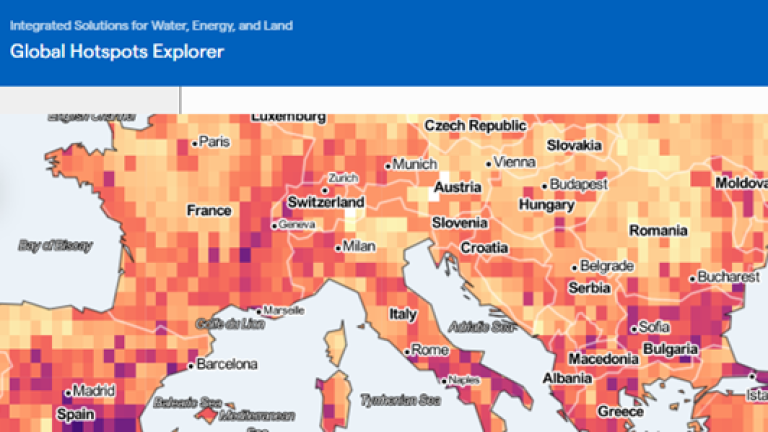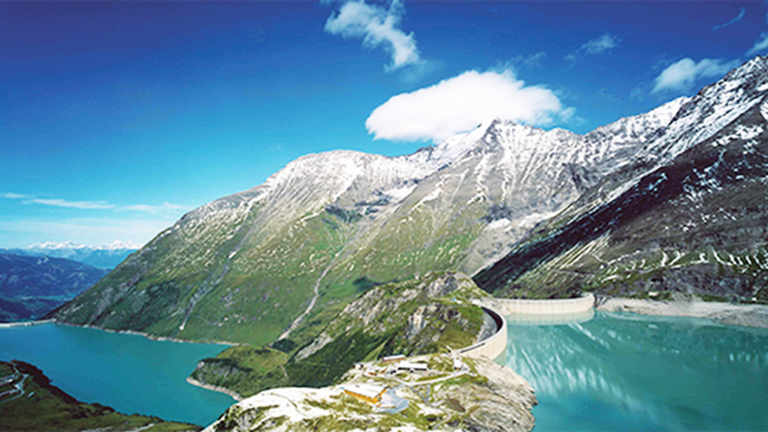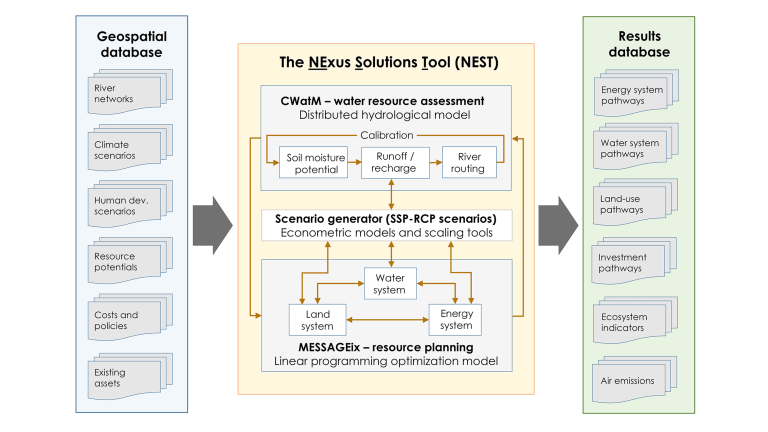
Natural resource constraints, mitigation policy and climate impacts have driven widespread interest in the important interdependencies between climate and the water, energy and land sectors. For almost a decade IIASA researchers have worked in this area using systems approaches, primarily at the global scale but increasingly at also national and river basin scales.
The Nexus theme continues pioneering work in water-energy-land systems’ models building on the legacy of the ISWEL project, through improved methods and representation of water, land and climate impacts information in MESSAGEix, NEST and other systems’ models.
Linking to other research groups at IIASA, this theme also works to better contextualize climate risks by improving the way that socioeconomic dimensions such as vulnerability and adaptive capacity are considered.
| Our recent research in Nature Sustainability illustrated how multi-lateral transboundary cooperation in the Indus river basin could more effectively deliver progress on the SDGs. |
The major challenges in this theme are:
- the representation of spatially explicit hydroclimate, water and land data within integrated assessment and energy systems’ optimization models, and
- understanding how these interact with socioeconomic dimensions such as governance, inequality, vulnerability and adaptation and affect progress towards meeting the SDGs
Research questions and approaches being addressed
|
Models, tools, and data
Examples of ongoing work

Meeting the core SDGs for rural sub-Saharan Africa
LEAP-RE - RE4AFAGRI aims at developing state-of-the-art climate-water-energy-land-food-environment nexus modelling in rural areas of developing countries to bridge the current gap between large-scale and local-scale analysis approaches.
| Our recent research is exploring the interactions between climate change, the power sector, and the challenge of energy access in the African region, also exploiting satellite data to create novel data products. |

Global hotspots of climate vulnerability
The Global Hotspots Explorer interactively maps and presents information about impacts, vulnerabilities and risks arising from development, climate change in the water, energy and land sectors.
State-of-the art models were used to assess the future trends of 14 indicators of development- and climate-induced challenges linked to three sectors–water, energy, and land. The underlying research contributed to the knowledge gap of climate impacts at 1.5 °C for the IPCC Special Report.

The role of storage in renewables integration
Increasing renewable sources of energy like wind and solar into the supply mix greatly benefits from storage options that can flexibly balance supply and demand. Hydropower and seasonal pumped storage (SPS) has the potential to supply long-term energy storage, and rapid, reliable and affordable electricity as well as water storage co-benefits. Ongoing work has mapped in detail the global potential of SPS and the benefits of storage in regional strategies are also being explored.

Heat stress, adaptive capacity, and energy demands for cooling
A warming climate brings both higher average and peak temperatures – putting stress on humans, animals, crops, and infrastructure systems, including energy supply and demand. But how will people and institutions cope with warmer temperatures, what is out capacity to adapt to changing conditions and what are the subsequent implications of our adaptation choices? Combining climate impacts, econometric and integrated assessment models, ongoing work explores the key drivers of capacity to adapt to climate impacts like heat stress and subsequent energy and emissions implications of keeping us cool.

Integrated assessment modelling of the nexus on a basin scale
NEST (Nexus Solutions Tool) is an open modeling platform that integrates multi-scale energy-water-land resource optimization with distributed hydrological modeling. NEST was originally developed for the ISWEL project and applied at river basin (Indus).
NEST links databases, processing scripts and state-of-the-art models covering multiple disciplines The core framework consists of a distributed hydrological model, CWatM, and a WEL resource supply planning model implemented in MESSAGEix, both capturing the historical period and a future time horizon.

Integrated assessment modelling of the nexus on a global scale
Global scales– further re-development is ongoing as part of the NAVIGATE and LEAP-RE projects.
This activity aims at improving the water system's representation in the model by linking to ISIMIP output of hydrological model and including river basin as spatial units in MESSAGE-GLOBIOM. In addition to this, the model has included a bottom-up representation of sectoral climate impacts for different water, energy and land sectors (e.g. AC cooling demand, hydropower potential, crop yields, precipitation and evapotranspiration), which improves the model reliability when studying different mitigation pathways.
Recently published work in the nexus area
Vinca, A. , Parkinson, S. , Riahi, K. , Byers, E. , Siddiqi, A., Muhammad, A., Ilyas, A., Yogeswaran, N., Willaarts, B. , Magnuszewski, P., Awais, M. , Rowe, A., & Djilali, N. (2021). Transboundary cooperation a potential route to sustainable development in the Indus basin. Nature Sustainability 4 331-339. 10.1038/s41893-020-00654-7.
Andrijevic, M. , Byers, E. , Mastrucci, A. , Smits, J., & Fuss, S. (2021). Future cooling gap in shared socioeconomic pathways. Environmental Research Letters 16 (9) e094053. 10.1088/1748-9326/ac2195.
Parkinson, S. & Hunt, J. (2020). The economic potential for rainfed agrivoltaics in groundwater stressed regions. Environmental Science & Technology Letters 7 (7) 525-531. 10.1021/acs.estlett.0c00349.
Wang, Y., Byers, E. , Parkinson, S. , Wanders, N., Wada, Y. , Mao, J., & Bielicki, J.M. (2019). Vulnerability of existing and planned coal-fired power plants in Developing Asia to changes in climate and water resources. Energy & Environmental Science 12 (10) 3164-3181. 10.1039/c9ee02058f.
Byers, E. , Gidden, M., Leclere, D., Burek, P. , Ebi, K.L., Greve, P., Grey, D., Havlik, P. , Hillers, A., Johnson, N., Kahil, T. , Krey, V. , Langan, S. , Nakicenovic, N., Novak, R., Obersteiner, M. , Pachauri, S. , Palazzo, A. , Parkinson, S. , Rao, N. , Rogelj, J. , Riahi, K. , Satoh, Y., Wada, Y. , & Willaarts, B. (2018). Global exposure and vulnerability to multi-sector development and climate change hotspots. Environmental Research Letters 13 e055012. 10.1088/1748-9326/aabf45.
Fricko, O. , Parkinson, S. , Johnson, N., Strubegger, M., van Vliet, M.T.H., & Riahi, K. (2016). Energy sector water use implications of a 2°C climate policy. Environmental Research Letters 11 (3) e034011. 10.1088/1748-9326/11/3/034011.
Vinca, A. , Parkinson, S. , Byers, E. , Burek, P. , Khan, Z., Krey, V. , Diuana, F., Wang, Y., Ilyas, A., Köberle, A.C., Staffel, I., Pfenninger, S., Muhammad, A., Rowe, A., Schaeffer, R., Rao, N. , Wada, Y. , Dhilali, N., & Riahi, K. (2019). The Nexus Solutions Tool (NEST): An open platform for optimizing multi-scale energy-water-land system transformations. Geoscientific Model Development Discussions 13 (3) 1095-1121. 10.5194/gmd-2019-134.
Hunt, J. , Byers, E. , Wada, Y. , Parkinson, S. , Gernaat, D.E.H.J., Langan, S. , van Vuuren, D.P., & Riahi, K. (2020). Global resource potential of seasonal pumped hydropower storage for energy and water storage. Nature Communications 11 (1) e947. 10.1038/s41467-020-14555-y.
